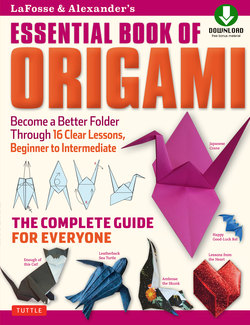Читать книгу LaFosse & Alexander's Essential Book of Origami - Michael G. LaFosse - Страница 13
На сайте Литреса книга снята с продажи.
ОглавлениеChoosing and Preparing Your Origami Paper
QUALITY CONSIDERATIONS
We fold a wide variety of papers, but lasting art requires quality not commonly found in readily available, decorative papers. Here’s what you should know:
Kraft
The most common papers readily available to the folding artist today are made from wood pulp. These are also the least expensive papers because trees (and tree-top scrap remaining from logging operations) are readily available, and trees are a renewable resource. Huge paper mills located in the northern climates continuously receive truckloads of trees, often from mixed species. The wood is chopped in large-scale machinery, and the inch-sized wood bits are soaked in water. The kraft process, a common method to process the wood bits with harsh chemicals (sodium hydroxide and sodium sulfide), was developed in Germany over a century ago. Since this treatment yields fiber that is strong enough for most general-purpose papers, it was given the name “kraft,” which means “strength” in German. The alkaline solution and wood mixture is cooked under high pressure with steam. This process quickly separates the brown, gooey, unwanted lignins from the desired fibers of cellulose. Today, that stock is often mixed with fiber from post-consumer paper recycling. You are probably most familiar with the sturdy brown paper grocery bags produced by the kraft process. When similar material is corrugated and laminated between layers to hold the ribs in place, it forms cardboard for boxes and packaging. Fiberboard for shoeboxes and cereal boxes are yet another familiar, less-refined kraft product.
A selection of handmade abaca papers made at the Origamido Studio.
Bond
